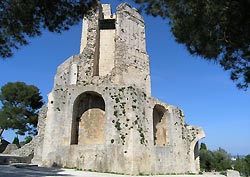Nîmes lies on a plain south of the Cévennes Mountains. It has strong historical links with the textile
industry – wool, cotton and silk have all successively contributed to the town’s wealth and development.
Originally a village inhabited by Gauls, Nîmes was annexed by Rome in 121 BC. The Romans transformed
the area, surrounded it with 6000 metres of walled fortifications along the Crête de sept petits mamelons. Then known
as Nemausus (from the name of its major source of water), the town flourished as one of Rome’s commercial colonies.
Nîmes is famous for its well preserved Roman monuments and its celebrations centred on bulls (Races,
Encierro, Abrivado). As a result of centuries of rearing bulls – a practice borrowed from Spain and the nearby
Camargue – the animals possess a legendary status in the area. The Féria de Pentecôte and the Féria
des Vendanges have made Nîmes internationally famous, its reputation cemented by the bons viveurs who live in the town,
eager to enjoy the sun while chatting outside the local cafés.
What to see and visit: the Grand Temple (eighteenth century); Saint-Paul (nineteenth century); the cathedral
(eleventh and sixteenth centuries); the Petit Temple (eighteenth century.); the Chapelle des Jésuites (seventeenth century);
amphitheatre (first century BC); Hôtel de Ville (town hall dating from the fifteenth and sixteenth centuries); town houses
from the sixteenth, seventeenth and eighteenth centuries; the Maison Carrée (5 AD); the Tour Magne (15/16 BC); the Temple
de Diane (first or second century); remains of the town’s ramparts and ancient Roman gates; the Porte d'Arles (also known
as the Porte d'Auguste) and Porte d'Espagne (also known as the Porte de France); the unique Castellum water system; Museum of
Archaeology and Natural History, Museum of Old Nîmes, Musée des Beaux-Arts, Musée des Cultures Taurines.
Recommended activities: small tourist train (tour of the town), health trail, Vacquerolles Golf Course, Clos
Gaillard and Bois des Espeisses nature trails.

